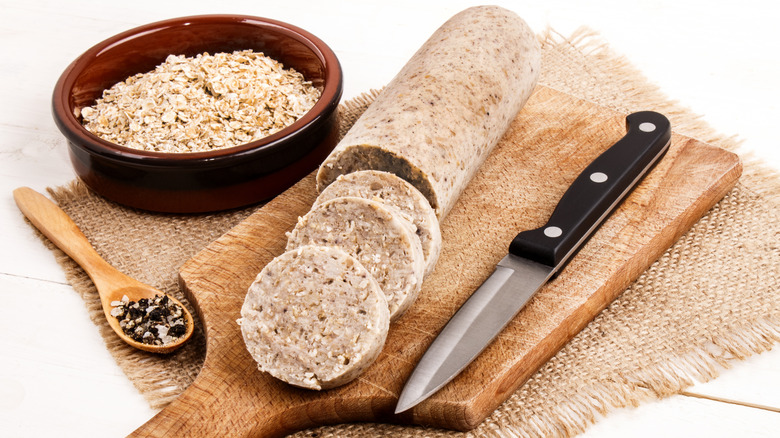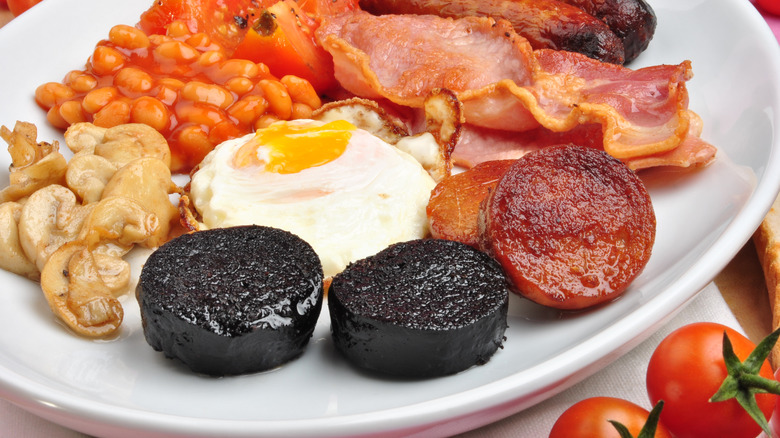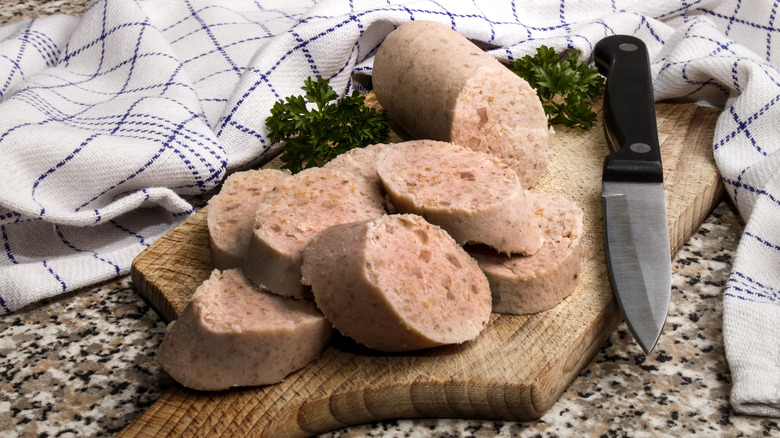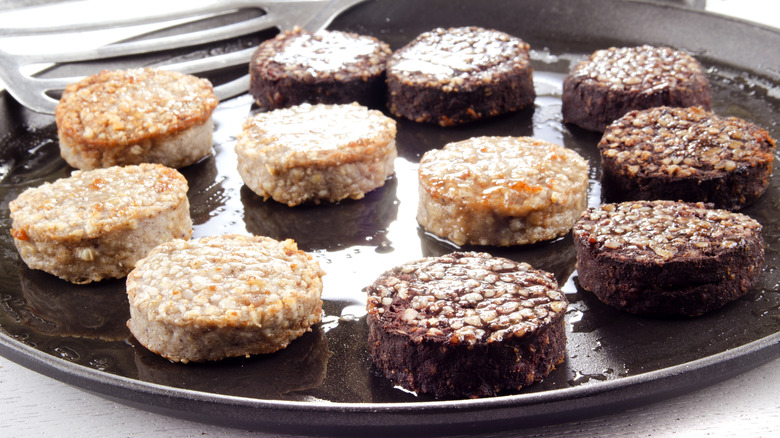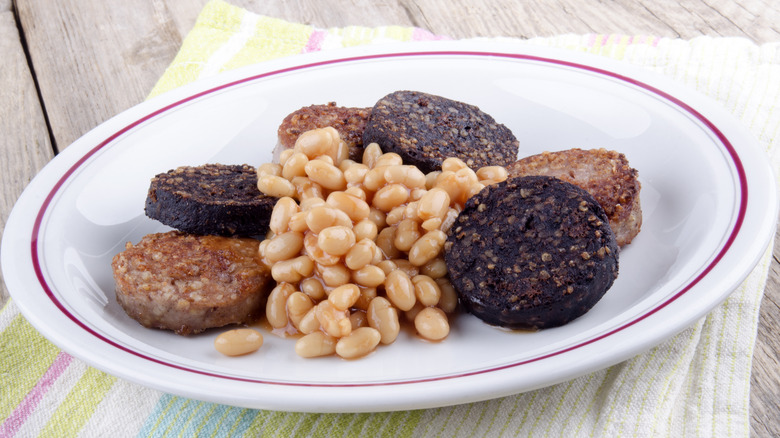White Pudding Vs Black Pudding: What's The Difference?
What are you doing for St. Patrick's Day? With the holiday fast approaching, hopefully you've got a plan in place, whether it's attending a parade, stirring some green food coloring into your favorite ale, or indulging in an Irish-themed feast.
The holiday commemorates the patron saint of Ireland, Patrick, a British-born missionary who was brought to Ireland as a child slave and who established many monasteries, schools, and churches across the country by the time of his death on March 17, 461, according to Britannica. With about 30 million Americans claiming Irish ancestry as of March 2021, it's a widely celebrated holiday in the U.S. — and one on which Irish dishes, such as corned beef and cabbage, are traditionally enjoyed.
Another Irish recipe that's sometimes spotted on St. Patrick's Day tables is pudding, whether of the white or black variety. Both are sausages made with a base of thick cereal, such as oats, but they differ markedly in various ways.
What is white pudding?
Although the word "pudding" refers to a sweet dairy-based dessert to most Americans, across the pond in Britain the term makes reference to any dish, savory or sweet, that's boiled or steamed inside a cloth or, traditionally, inside an animal intestine: Think of spotted dick, the currant-studded steamed cake that's flavored with beef suet (via Vox). A well-known Irish dish in this category is white pudding, a grain-based sausage flavored with plenty of fat and then stuffed into a sausage casing.
Masterclass explains that white pudding typically uses oatmeal or barley, pork or beef suet, breadcrumbs, spices, and occasionally pork meat or pork liver. Originally invented as a way for butchers to use up extra animal fat and innards, white pudding is still enjoyed today, often as a part of a traditional Irish breakfast alongside baked beans, eggs, mushrooms, and broiled tomatoes, notes The Spruce Eats.
Rich with fat and firm with grain, white pudding features flavors of the onions used to season the sausage, and typically includes fragrant spices such as white pepper and coriander. It has a light brown or beige color, notes Masterclass.
What is black pudding?
White pudding and black pudding are very similar, both originating in Britain and both featuring a base of grain and animal fat. But Masterclass explains that black pudding varies from white in a very significant way, with the addition of plenty of beef or pork blood, making it a traditional blood sausage. As with white pudding, black pudding was a way for butchers to make a new product from meat scraps, offal, and blood — instead of having to throw these items out.
Black pudding is made by mixing pig or cow blood with pork or beef suet and a grain (usually oatmeal), and then stuffing the mixture into a casing, BBC Good Food explains. The sausage is served boiled, grilled, or fried, often part of a traditional Irish breakfast like white pudding. Masterclass notes that the sausage can have a slightly metallic taste because of the presence of iron-rich blood, and Irish Expressions writes that it can be flavored with onion and spices. Black pudding, like other blood puddings, takes on a dark red or brownish color.
How to make white pudding
According to 2 Guys & A Cooler, a recipe blog focused on homemade charcuterie and cheeses, the secret to making white pudding is to use a lot of fat — and to keep it very cold. The recipe starts by cubing fat back from a pig's back, and placing it in the freezer. Once it's frozen, the fat is ground in a meat grinder using a six millimeter plate. For the filling, the fat gets mixed with pearl barley cooked in chicken stock, finely chopped and sautéed leeks, all purpose flour, cornstarch, whole milk, and seasonings, including salt, white pepper, and coriander. The mixture is stuffed into natural hog casings and then poached in simmering water for 35-40 minutes, until firm. Once cooled, the white pudding can be sliced and pan-fried to get a nice crispy exterior, and served as part of a traditional Irish breakfast.
How to make black pudding
For its black pudding recipe, Irish Expressions calls for boiling pork liver in lightly salted water until tender. Once cooled, the liver is minced and mixed with fresh, chopped, unrendered lard, 3 quarts of fresh pigs' blood, 2 pounds of fresh bread crumbs, oatmeal, chopped onions, salt, and allspice. This mixture is moistened as needed with the liver cooking liquid, then packed into natural sausage casings and tied off in one-foot loops.
The Rustic Elk recommends poaching the sausages in simmering water for 15-20 minutes, then shocking the sausages in a bowl of ice water, removing them, and letting them dry for an hour. Black sausage can be sliced into thick rounds and enjoyed as-is or pan-fried until crispy on the outside. Other suggestions from BBC Good Food include crumbling it into mashed potatoes, over the top of a puréed soup, or, of course, including it in an Irish breakfast.
Where to buy white and black pudding
If you're celebrating St. Patrick's Day in the U.S. and want to pick up some white or black pudding for an Irish-themed feast, your best bet is to head to an Irish butcher to buy some that's been made fresh. If you live near heavily Irish cities such as Boston, Philadelphia, or Louisville, this task should be particularly easy to accomplish.
Otherwise, there's always the internet. Quality prepared black pudding can be ordered online through Food Ireland, Tommy Moloney's, and Parker's, while white pudding can also be sourced from Food Ireland, Tommy Moloney's, and Parker's.
Forman & Field recommends storing black pudding in the refrigerator for up to two weeks, or in the freezer for up to one month, while Charles Macleod recommends refrigerating white pudding and consuming it within one week of opening, or freezing the pudding for up to three months. Whether your pudding of choice is white or black, it should make for a delicious St. Patrick's Day meal.

